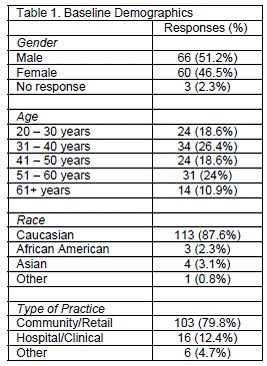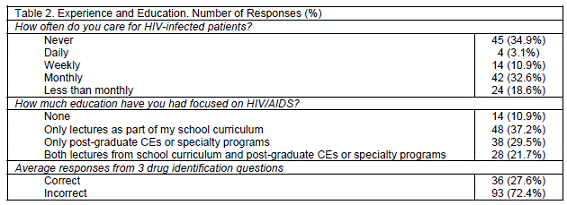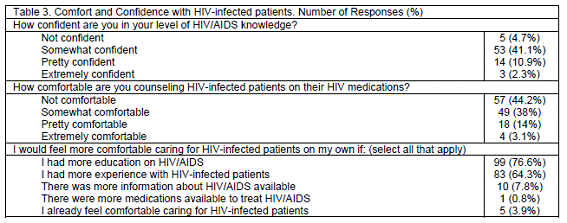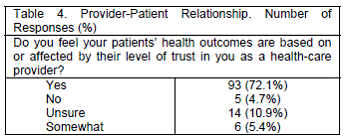Mi SciELO
Servicios Personalizados
Revista
Articulo
Indicadores
-
 Citado por SciELO
Citado por SciELO -
 Accesos
Accesos
Links relacionados
-
 Citado por Google
Citado por Google -
 Similares en
SciELO
Similares en
SciELO -
 Similares en Google
Similares en Google
Compartir
Pharmacy Practice (Granada)
versión On-line ISSN 1886-3655versión impresa ISSN 1885-642X
Pharmacy Pract (Granada) vol.10 no.4 Redondela oct./dic. 2012
ORIGINAL RESEARCH
Assessing pharmacists' perspectives of HIV and the care of HIV-infected patients in Alabama
Evaluando las perspectivas de los farmacéuticos sobre el VIH y la atención de los pacientes infectados de VIH en Alabama
Margaret Davis Pate1, Ami T. Shell2 and Sean R. King3.
1PharmD. Pharmacy Practitioner. University of Alabama Hospital at Birmingham. Birmingham, AL (United States)
2PharmD, BCPS, AAHIVE. Professor. McWhorter School of Pharmacy, Samford University. Birmingham, AL (United States)
3MS, PhD. Assistant Professor. Union University School of Pharmacy. Jackson, TN (United States)
SUMMARY
Objective: The purpose was to assess factors potentially affecting care pharmacists provide to HIV/AIDS patients including comfort level, confidence, education, experience, professional competence, continuity of care and patient-provider relationship between pharmacists and HIV-infected patients.
Methods: A 24-item questionnaire assessed the constructs of this study. Surveys were distributed from October 2009 to April 2010 to pharmacists in Alabama with varying levels of experience treating HIV-infected patients. Chi-square tests determined whether relationships existed between responses, consisting of how often respondents reported treating HIV-infected patients, amount of HIV education respondents had, participants' confidence with HIV/AIDS knowledge and comfort level counseling HIV-infected patients about their medications.
Results: Thirty-three percent of the pharmacists cared for HIV-infected patients on a monthly basis, yet 86% do not feel very confident with their HIV/AIDS knowledge. Forty-four percent were not comfortable counseling patients on antiretroviral medications, and 77% would feel more comfortable with more education. Significant, positive relationships were revealed concerning how often respondents treat HIV-infected patients and their comfort level counseling them (r=0.208, p<0.05). Similar relationships pertaining to the amount of education respondents had regarding HIV, how confident they are in their HIV/AIDS knowledge (r=0.205, p< 0.05), and their comfort level counseling HIV-infected patients on their medications (r=0.312, p<0.01) were found. The time spent treating HIV-infected patients and the education respondents had pertaining to HIV/AIDS related to increased comfort levels concerning counseling patients on their medications.
Conclusion: This research uncovered areas where pharmacists can improve care and treatment for HIV-infected patients. Increasing education on HIV/AIDS and treatment options may lead to increased comfort and confidence in therapeutic management. Through changes in pharmacists' perspectives and abilities to care for their patients, the patient-provider relationship could strengthen, potentially leading to improved medication compliance, enhanced overall health, and a better quality of life for HIV-infected patients.
Key words: Acquired Immunodeficiency Syndrome. Health Knowledge, Attitudes, Practice. Pharmacists. United States.
RESUMEN
Objetivo: El propósito fue evaluar los factores que potencialmente afectan la atención proporcionada por farmacéuticos a pacientes VIH/SIDA incluyendo niveles de comodidad, educación, competencia, continuidad de cuidados, y relación paciente-profesional entre los farmacéuticos y los pacientes infectados con VIH.
Métodos: Un cuestionario de 24 ítems evaluó los constructos de este estudio. Entre octubre 2009 y abril 2010 se distribuyeron las encuestas a farmacéuticos de Alabama con varios niveles de experiencia en el tratamiento de pacientes infectados de VIH. Pruebas chi-cuadrado determinaron si existía asociación entre las respuestas y lo a menudo que los respondedores trataban pacientes infectados con VIH, la educación que tenían, la confianza con sus conocimientos sobre VIH/SIDA y el nivel de comodidad aconsejando a los pacientes infectados con VIH sobre sus medicamentos.
Resultados: El 33% de los farmacéuticos atendía pacientes infectados por VIH mensualmente, aunque el 86% no se sentía muy cómodo con sus conocimientos sobre VIH/SIDA. El 44% no estaba cómodo aconsejando a los pacientes sobre medicamentos antirretrovirales y el 77% se sentiría más cómodo con más educación. Se encontró una relación positiva entre la frecuencia con la que los respondentes trataban pacientes con VIH y su nivel de comodidad (r= 0.208, p<0.05). Aparecieron relaciones semejantes entre la cantidad de educación que tenían los respondentes sobre VIH, lo confiados que estaban en sus conocimientos sobre VIH/SIDA (r= 0.205, p< 0.05), y su nivel de comodidad cuando aconsejan pacientes con VIH sobre su medicación (r= 0.312, p< 0.01). El tiempo dedicado a tratar pacientes con VIH y la educación que los respondentes tenían sobre VIH/SIDA se relacionaba con mayores niveles de comodidad al aconsejar a los pacientes sobre sus medicaciones.
Conclusión: Esta investigación desveló las áreas donde los farmacéuticos pueden mejorar la atención y el tratamiento de pacientes infctados con VIH. Aumentar la educación sobre VIH/SIDA y sus opciones de tratamiento puede llevar a un aumento de comodidad y confianza en la gestión de la terapéutica. Mediante cambios en las perspectivas y capacidades de cuidar pacientes de los farmacéuticos puede reforzarse la relación paciente-profesional, llevando potencialmente a un mejor cumplimento terapéutico, aumentando la salud en general y mejorando la calidad de vida de los pacientes con VIH.
Palabras clave: Síndrome de Inmunodeficiencia Adquirida. Conocimientos, Actitudes y Práctica en Salud. Farmacéuticos. Estados Unidos.
Introduction
As of the end of 2008, an estimated 1.2 million persons, 13 years of age and older, in the United States were infected and living with HIV, while 20% had HIV but were unaware of their status.1 It is also estimated that approximately 50,000 people in the United States are newly infected with HIV each year.2 Over the past 25 years, several aspects about this disease have changed, ranging from knowledge of its genetic makeup, transmission, forms of treatment, and therapies.3 Along with the continued growth, attitudes towards and treatment of HIV-infected patients have transformed; however, vast differences in the way HIV-infected patients are viewed and treated by health care providers still exist.4
Initially, most of the focus for HIV was attributed to gay males, generating a vast stigma over the gay community as well as the diagnosis of HIV, which in turn affected how health care professionals were treating HIV.8 Over time the knowledgebase surrounding the natural history of this disease increased, more treatment options became available, and the infectious vectors expanded to include heterosexual males and females. Following such alterations, the stigma surrounding the diagnosis of HIV declined slightly but still had a lingering effect on patients' treatment and health-care providers' perspective.8
Stigmas regarding this disease exist not only within the general population and health care industry, but are also issues HIV/AIDS patients struggle with internally. When assessing stigma in the general population towards HIV patients, the two main areas investigated include social distancing and support for coercive measures towards HIV/AIDS patients and attitudes and values.8 A study analyzing the prevalence and trends of HIV-related stigma in the 1990s assessed the general public's trust of health experts conveying information about AIDS. While this study showed an increase in the public's trust of health experts, in 1999 only 70% believed scientists and doctors could be trusted to tell the truth about AIDS.9
In the 1980s, the first drugs for managing HIV were approved as well as other medications for treating and preventing certain opportunistic infections common among HIV patients.10 Within the next decade, several drugs were available for the management of HIV. However, once a patient is initiated on antiretroviral therapy, medication adherence is essential. In most other chronic disease states 80%11 compliance is recommended; in HIV, 95% adherence is needed due to increased risk of resistance and viral mutation.1 Patients not meeting this recommendation are at a significantly increased risk for resistance to the antiretroviral medications, which will lead to clinical failure.12 Antiretroviral medications, viral load monitoring and adherence counseling are critical to the improvement and maintenance of health to HIV-infected patients. Studies have shown a direct relationship between HIV/AIDS medication adherence and proper communication/medication counseling with health care providers.12,13 Medication adherence is an important area where pharmacists can have tremendous influence; however, for their contribution to be significant, pharmacists must be comfortable and confident when counseling and caring for HIV-infected patients.
Rationale
While there is extensive research focusing on HIV-infected patients' perspective of their health care and patient-provider relationship, there is very little research focusing on the health care providers' perspective.14 Research was conducted in the beginning of the HIV epidemic analyzing health-care provider's stigmatization towards HIV-infected patients.14 In 1989, an article described how mass media and even professional publications referred to patients with AIDS related manifestations as -lepers'.15 A study published in 1990, which surveyed college students, nurses, medical and chiropractic students concluded that AIDS was the "least understood medically and most deadly of diseases" when compared to cancer, diabetes and heart disease.16 However, with increased education and experience in treating HIV-infected patients, this prejudice has decreased.4 The purpose in conducting this research was to assess and compare the comfort level, confidence, education, experience, and professional competence, as well as continuity of care and the patient-provider relationship of pharmacists in Alabama with HIV-infected patients. These variables were applied as they related to differences in the pharmacists' outlooks and their approach to care for HIV-infected patients.
From January 1988, when HIV reporting began in Alabama, through 2007, 6,430 patients were diagnosed with HIV. There have been 10,316 reported patients living with HIV in Alabama through 2008.17 A total of 11,096 patients in Alabama were diagnosed with HIV/AIDS and 4,344 patients were living in Alabama with a diagnosis of AIDS as of the end of 2010.14 As of the end of 2008, 4,465 patients diagnosed with HIV/AIDS resided in the Birmingham and Hoover area.18 According to a 2009 report, Alabama was ranked 22nd highest among the 50 states in cumulative reported AIDS cases, with New York and Florida in the lead respectively.19
This research will increase awareness of the need for additional education, comfort, and confidence of pharmacists caring for HIV-infected patients. Examining the perspective of pharmacists may reveal potential areas of patient care that need to be improved upon and expose existing limitations in the treatment of HIV-infected patients. This research serves as a benchmark to quantify the current status of pharmacists' acceptance of HIV and the quality of treatment offered to HIV patients when compared to research conducted in other countries.
Methods
This research was designed to determine pharmacists' perspective concerning HIV and HIV-infected patients. In order to obtain the necessary information, surveys were utilized to assess pharmacists' comfort levels, confidence, education, experience, professional competence, continuity of care, and the patient-provider relationship in relation to both HIV and HIV-infected patients (online Appendix). These surveys were distributed to pharmacists throughout the state of Alabama by hand and via facsimile with the help of American Pharmacy Cooperative, Inc, a member-owned group purchasing organization, established to protect and promote the interest of independent pharmacies. The surveys were distributed to pharmacists throughout the area with varying levels of experience caring for HIV-infected patients. All pharmacists surveyed were adults, greater than 18 years of age, whose participation was anonymous and voluntary. No financial incentives were provided for participation in this study and written informed consent was not obtained. Study procedures and tools were approved by Institutional Review Boards at Samford University and Cooper Green Mercy Hospital in Birmingham, Alabama.
Data was collected from October 2009 through April 2010. Since no existing instrument analyzed all the dimensions desired for this study, an original 24-item questionnaire was developed. Survey responses were analyzed for frequency, distribution, and regression analysis with SPSS 17.0 analytical software. The survey analyzed baseline demographics (Table 1), HIV experience and education (Table 2), comfort level and confidence in dealing with HIV-infected patients (Table 3), continuity of care, and the patient-provider relationship and professional competence of pharmacists (Table 4). Experience and education were measured by how many HIV-infected patients for whom the responders cared, how frequently they cared for them, what their experience with HIV-infected patients has been, what type of HIV/AIDS education they have had and their knowledge of certain antiretroviral drug classes. Comfort level and confidence were ranked on four levels ranging from not confident/comfortable to extremely confident/comfortable and also gauged by what scenarios would make them more comfortable caring for HIV-infected patients. Continuity of care was evaluated by assessing the providers' relationship to the patients and looking at the patients' show rate for follow-up visits. Questions focusing on trust, respect, compliance, and inclusion of patients in decisions were used to assess the patient-provider relationship and professional competence.
Results
The study sample, 129 responses, was a result of pharmacists who voluntarily decided to complete and return the survey via facsimile or by hand. The 129 participants consisted of 51.2% male with 18.6% being between 20-30 years of age, 26.4% between 31-40 years of age, 18.6% between 41-50 years of age, 24% between 51-60 years of age, and 10.9% being 61 years of age or older. The ethnicity of the sample was Caucasian, 87.6%; African American, 2.3%; Asian, 3.1%; and Other, 0.8%. The majority of the sample (79.8%) worked in the community or retail setting; the survey did not specifically address the two settings separately. While 32.6% of the pharmacists surveyed care for HIV-infected patients on a monthly basis, an average of 72.4% of responders missed the three drug identification questions and 86.1% of responders documented they do not feel very confident with their HIV/AIDS knowledge. 44.2% marked they are not comfortable counseling patients on antiretroviral medications while 38% needed a second opinion or confirmation before counseling, and 76.7% would feel more comfortable caring for HIV-infected patients if they had more education. However, even with these findings, 58.9% of responders felt, in regards to the patient-provider relationship, their patients trusted them about their therapy and treatment. The majority (72.1%) of the respondents to this survey believed the patient-provider relationship existed and an astounding 80.6% of the pharmacists included their patients in the health-care decision-making process. One pharmacist even added in the additional comments section, if (patients) are consulted they are more likely to feel a part and likely to be compliant". (Tables 1 to 4).
Chi-square tests were used to determine whether relationships existed between how often respondents reported treating HIV infected patients and the amount of education respondents have concerning HIV, how confident respondents are in their HIV/AIDS knowledge and how comfortable they are counseling HIV infected patients on their HIV medications. A significant relationship was revealed between how often respondents reported treating HIV infected patients and how comfortable they are counseling HIV infected patients about their HIV medications (p< 0.05) as well as how confident they are in their HIV/AIDS knowledge (p<0.05). Significant relationships were also revealed pertaining to the amount of education respondents had regarding HIV and how confident they are in their HIV/AIDS knowledge (p<0.05) and how comfortable they are counseling HIV infected patients on their medications (p<0.05).
The amount of time spent treating HIV infected patients and the amount of education respondents reported to possess pertaining to HIV/AIDS was related to increased comfort levels concerning counseling patients on their HIV medications and increased confidence in their HIV/AIDS knowledge.
Discussion
A great deal of research has been devoted to HIV-infected patient's perspectives of their health, treatment, and patient-provider relationship. The majority of the studies found that compliance, trust and respect, both for and from the health care provider, went hand-in-hand with one another and correlated to the overall health of the patients, medication compliance, and frequency of office visits.14,20,21 This study examined the relationship from the pharmacist's perspective, to determine how much exposure pharmacists have with patients possessing HIV, how they interpret their knowledge of HIV and antiretroviral drug therapy, their confidence in providing counseling and comfort with providing medication counseling.
It is important to note that most pharmacists who participated in this study reported having some sort of education focused on HIV either during school or as continuing education, but 10.9% reported having none. Some states require HIV-specific continuing education as a mandate for licensure, but Alabama does not have this requirement. This ten percent could account for some of the responses related to a lack of knowledge and confidence but cannot fully account for the numbers received. Over seventy percent of the drug identification answers were incorrect. It is likely that if a pharmacist cannot identify the class that a medication belongs to, he or she may not know specific patient counseling information, pertinent drug interactions, or appropriateness of an antiretroviral regimen. Only 3.9% of respondents reported feeling comfortable with caring for HIV-infected patients and over seventy-five percent stated that their comfort level would improve if they had more education on HIV/AIDS.
Unfortunately, there has been limited research conducted within the United States regarding the healthcare providers' attitudes towards treating patients and their diseases, especially in regards to HIV and the treatment of HIV-infected patients. This study began data collection focused on the health care providers' perspectives and concerns regarding HIV and the treatment of HIV-infected patients in Alabama. Also, it explored whether Alabama pharmacists experience different patient-provider relationships, confidence in knowledge, and professional competence in regard to HIV patients and the treatment of HIV. This data should lead to more research designed to derive why these differences exist. Because the majority of the pharmacists responding to the survey were from a community setting, no conclusions could be made between pharmacists from different practice settings.
Conclusions
The results of this survey uncovered areas where pharmacists can continue to improve their care and treatment for HIV-infected patients. Increasing education on HIV/AIDS and treatment options for HIV may lead to increased comfort and confidence in therapeutic management of HIV-infected patients. This survey did not go into detail about each HIV medication and the specific patient counseling points a pharmacist would need to know in order to provide optimal care for their patients. However, by asking the respondents to identify the class in which three common HIV medications are grouped, the majority were incorrect or stated they were unaware of the answer, allowing the assumption to be made that they would be unable to properly counsel their patients. Even when respondents reported treating HIV-infected patients more frequently, they were more confident and comfortable counseling patients about their medications than in their HIV/AIDS knowledge, which causes concern for the depth and accuracy of the information being given to patients.
Through changes in pharmacists' perspectives and abilities to care for their HIV-infected patients, this research aims to strengthen the patient-provider relationship, leading to improved medication compliance, enhanced overall health, and a better quality of life for HIV-infected patients. Future research built upon this study could determine how to eliminate existing limitations providing pharmaceutical care to HIV-infected patients, as well as investigate how antiretroviral therapy alters health care providers' attitudes towards and interactions with HIV-infected patients.14
Conflict of interest
The authors have nothing to disclose concerning possible financial or personal relationships with commercial entities (or their competitors) that may be referenced in this manuscript.
No funding or financial aid was provided in the development of this research.
References
1. Centers for Disease and Prevention. HIV surveillance - United States, 1981-2008. MMWR. 2011;60(21):689-693. [ Links ]
2. Prejean J, Song R, Hernandez A, Ziebell R, Green T, Walker F, Lin LS, An Q, Mermin J, Lansky A, Hall HI. Estimated HIV Incidence in the United States, 2006-2009. PLoS One. 2011;6(8):e17502. doi:10.1371/journal.pone.0017502 [ Links ]
3. Cichocki M. The history of HIV; An HIV timeline. About.com (Accessed September 23, 2009). [ Links ]
4. Nyblade LC. Measuring HIV stigma: existing knowledge and gaps. Psychol Health Med. 2006;11(3):335-345. [ Links ]
5. Fight AIDS at home. http://fightaidsathome.scripps.edu/glossary.html#h (Accessed September 23, 2009). [ Links ]
6. The body: The complete HIV/AIDS resource. http://www.thebody.com/content/art2506.html (Accessed September 23, 2009). [ Links ]
7. Centers for Disease and Prevention. AIDS defining conditions. MMWR 2008; 57(RR10); 9. http://www.cdc.gov/mmwr/preview/mmwrhtml/rr5710a2.htm (Accessed September 25, 2009). [ Links ]
8. Sade RM. HIV/AIDS as an epidemic: ethical issues at the 20th anniversary. Health Care Anal. 2002;10(1):1-4. [ Links ]
9. Herek GM, Capitanio JP, Widaman KF. HIV-related stigma and knowledge in the United States: prevalence and trends, 1991-1999. Am J Public Health. 2002;92(3):371-377. [ Links ]
10. US department of health and human services. http://www.fda.gov/ForConsumers/ByAudience/ForPatientAdvocates/HIVandAIDSActivities/ucm117935.htm (Accessed September 23, 2009). [ Links ]
11. International society for pharmacoeconomics and outcomes research. ISPOR medication compliance and persistence special interest group (MCP). http://www.ispor.org/sigs/medcompliance/Integrating MedCompl.asp (Accessed November 23, 2009). [ Links ]
12. Roberts KJ. Physician-patient relationships, patient satisfaction, and antiretroviral medication adherence among HIV-infected adults attending a public health clinic. AIDS Patient Care STDS. 2002;16(1):43-50. [ Links ]
13. McCoy L. HIV-positive patients and the doctor-patient relationship: perspectives from the margins. Qual Health Res. 2005;15(6):791-806. [ Links ]
14. Rajaraman D, Palmer N. Changing roles and responses of health care workers in HIV treatment and care. Trop Med Int Health. 2008;13(11):1357-1363. [ Links ]
15. Volinn IJ. Issues of definitions and their implications: AIDS and leprosy. Soc Sci Med. 1989;29(10):1157-1162. [ Links ]
16. Walkey FH, Taylor AJ, Green DE. Attitudes to AIDS: a comparative analysis of a new and negative stereotype. Soc Sci Med. 1990;30(5):549-52. [ Links ]
17. Centers for Disease Control and Prevention. HIV surveillance report: Diagnoses of HIV infection and AIDS in the United States and Dependent Areas, 2009. Vol. 21. http://www.cdc.gov/hiv/topics/surveillance/resources/reports/ (Accessed March 27, 2011). [ Links ]
18. Centers for Disease Control and Prevention. HIV Surveillance Report: Diagnoses of HIV infection and AIDS in the United States and Dependent Areas, 2009. Alabama Department of Public Health, Alabama AIDS and HIV Quarterly Statistics, Demographics (January - July 2011). http://roadtoaids2012.org/cities/birmingham.htm (Accessed February 27, 2012). [ Links ]
19. Centers for Disease Control and Prevention. National center for HIV/AIDS, viral hepatitis, STD, and TB prevention. http://www.cdc.gov/nchhstp/stateprofiles/pdf/alabama_profile.pdf (Accessed February 27, 2012). [ Links ]
20. Whetten K, Leserman J, Whetten R, Ostermann J, Thielman N, Swartz M, Stangl D. Exploring lack of trust in care providers and the government as a barrier to health service use. Am J Public Health. 2006;96(4):716-721. [ Links ]
21. Gilson L, Palmer N, Schneider H. Trust and health worker performance: exploring a conceptual framework using South African evidence. Soc Sci Med. 2005;61(7):1418-1429. [ Links ]
22. Malta M, Petersen ML, Clair S, Freitas F, Bastos FI. Adherence to antiretroviral therapy: qualitative study with physicians from Rio de Janeiro, Brazil. Cad Saude Publica. 2005;21(5):1424-1432. [ Links ]
23. Infante C, Zarco A, Magali-Cuadra S, Morrison K, Caballero M, Bronfman M, Magis C. HIV/AIDS-related stigma and discrimination: the case of health care providers in Mexico. Salud Publica Mex. 2006;48(2):141-150. [ Links ]
24. Kruse GR, Chapula BT, Ikeda S, Nkhoma M, Quiterio N, Pankratz D, Mataka K, Chi BH, Bond V, Reid SE. (2008) Health Care workers in Lusaka District:a Survey of Utilization of HIV Services and Burnout May-June 2007. Presentation to Sisters in Charge, Lusaka, Zambia. [ Links ]
25. Stein J, Lewin S, Fairall L. Hope is the pillar of the universe: health-care providers' experiences of delivering anti-retroviral therapy in primary health-care clinics in the free state province of South Africa. Soc Sci Med. 2007;64(4):954-64. [ Links ]
Received (first version): 31.03.12
Accepted: 06.12.12


















